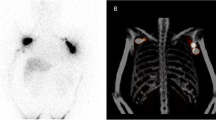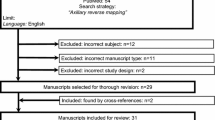Abstract
Background
Controversy in axillary reverse mapping in axillary lymph node dissection (ALND) possibly results from incomplete recognition of the arm lymphatic system (ALS) and its compromise to oncological safety. The iDEntification and Preservation of ARm lymphaTic system (DEPART) technique facilitates complete identification of ALS; therefore, its use may decrease the occurrence of arm lymphedema. This study aimed to examine the arm lymphedema rate, locoregional recurrence, and feasibility to perform DEPART in ALND.
Methods
Patients from February 2013 to October 2017 from two tertiary referral centers were randomly assigned to two groups. In the study group, indocyanine green and methylene blue (MB) were utilized to identify arm sentinel nodes, and 0.1 ml MB was injected into the arm sentinel nodes to reveal the subsequent-echelon nodes and lymphatics. Gross arm lymph nodes were examined by intraoperative partial frozen section and were removed if positive. Arm lymphedema, local recurrence, regional recurrence, and distant metastasis were recorded at different follow-up examinations.
Results
Arm sentinel nodes were identified in 573 (83.2%) patients. Subsequent-echelon nodes and lymphatics were visualized in 558 (97.4%) patients. Metastatic arm nodes were identified in 38 (6.8%) patients. The arm lymphedema rate was 3.3% (18/543) in the study group versus 15.3% (99/648) in the control group (p < 0.001) after 37-month median follow-up. Regional recurrence showed no difference between the two groups (1.4% and 1.2%, respectively) (p = 0.392).
Conclusions
DEPART can benefit breast cancer patients who undergo ALND, reducing the arm lymphedema rate without adversely affecting the morbidity of regional recurrence.


Similar content being viewed by others
References
Togawa K, Ma H, Sullivan-Halley J, et al. Risk factors for self-reported arm lymphedema among female breast cancer survivors: a prospective cohort study. Breast Cancer Res. 2014;4:414.
Thompson M, Korourian S, Henry-Tillman R, et al. Axillary reverse mapping (ARM): a new concept to identify and enhance lymphatic preservation. Ann Surg Oncol. 2007;6:1890–95.
Nos C, Lesieur B, Clough KB, Lecuru F. Blue dye injection in the arm in order to conserve the lymphatic drainage of the arm in breast cancer patients requiring an axillary dissection. Ann Surg Oncol. 2007;9:2490–96.
Hama Y, Koyama Y, Urano Y, Choyke PL, Kobayashi H. Simultaneous two-color spectral fluorescence lymphangiography with near infrared quantum dots to map two lymphatic flows from the breast and the upper extremity. Breast Cancer Res Treat. 2007;1:23–28.
Tummel E, Ochoa D, Korourian S, et al. Does axillary reverse mapping prevent lymphedema after lymphadenectomy? Ann Surg. 2017;5:987–92.
Schunemann E, Dória MT, Silvestre JBCH, Gasperin P, Cavalcanti TCS, Budel VM. Prospective study evaluating oncological safety of axillary reverse mapping. Ann Surg Oncol. 2014;7:2197–202.
Bains SK, Stanton AWB, Cintolesi V, et al. A constitutional predisposition to breast cancer-related lymphoedema and effect of axillary lymph node surgery on forearm muscle lymph flow. The Breast. 2015;1:68–74.
Beek MA, Gobardhan PD, Schoenmaeckers EJP, et al. Axillary reverse mapping in axillary surgery for breast cancer: an update of the current status. Breast Cancer Res Treat. 2016;3:421–32.
Suami H, Taylor GI, Pan W. The lymphatic territories of the upper limb: anatomical study and clinical implications. Plast Reconstr Surg. 2007;6:1813–22.
Pavlista D, Eliska O. Analysis of direct oil contrast lymphography of upper limb lymphatics traversing the axilla—a lesson from the past: contribution to the concept of axillary reverse mapping. Eur J Surg Oncol. 2012;5:390–4.
Ahmed M, Rubio IT, Kovacs T, Klimberg VS, Douek M. Systematic review of axillary reverse mapping in breast cancer. Br J Surg. 2016;3:170–8.
Ochoa D, Korourian S, Boneti C, Adkins L, Badgwell B, Klimberg VS. Axillary reverse mapping: five-year experience. Surgery. 2014;5:1261–8.
Ngui NK, French J, Kilby CJ, Pathmanathan N, Elder EE. Axillary reverse mapping in patients with breast cancer: is it oncologically safe? J Surg Oncol. 2016;7:726–31.
Noguchi M, Noguchi M, Ohno Y, et al. Feasibility study of axillary reverse mapping for patients with clinically node-negative breast cancer. Eur J Surg Oncol. 2016;5:650–6.
Foster D, Choy N, Porter C, Ahmed S, Wapnir I. Axillary reverse mapping with indocyanine green or isosulfan blue demonstrate similar crossover rates to radiotracer identified sentinel nodes. J Surg Oncol. 2018;3:336–40.
Yue T, Zhuang D, Zhou P, et al. A prospective study to assess the feasibility of axillary reverse mapping and evaluate its effect on preventing lymphedema in breast cancer patients. Clin Breast Cancer. 2015;4:301–6.
Han JW, Seo YJ, Choi JE, Kang SH, Bae YK, Lee SJ. The efficacy of arm node preserving surgery using axillary reverse mapping for preventing lymphedema in patients with breast cancer. J Breast Cancer. 2012;1:91.
Beaton DE, Wright JG, Katz JN. Development of the QuickDASH: comparison of three item-reduction approaches. J Bone Jt Surg Am. 2005;5:1038–46.
Noguchi M, Noguchi M, Nakano Y, Ohno Y, Kosaka T. Axillary reverse mapping using a fluorescence imaging system in breast cancer. J Surg Oncol. 2012;3:229–34.
Noguchi M, Yokoi M, Nakano Y. Axillary reverse mapping with indocyanine fluorescence imaging in patients with breast cancer. J Surg Oncol. 2010;n/a–n/a.
Nos C, Clough KB, Bonnier P, et al. Upper outer boundaries of the axillary dissection. Result of the SENTIBRAS protocol: multicentric protocol using axillary reverse mapping in breast cancer patients requiring axillary dissection. Eur J Surg Oncol. 2016;12:1827–33.
Boneti C, Korourian S, Bland K, et al. Axillary reverse mapping: mapping and preserving arm lymphatics may be important in preventing lymphedema during sentinel lymph node biopsy. J Am Coll Surg. 2008;5:1038–42.
Boneti C, Korourian S, Diaz Z, et al. Scientific impact award: axillary reverse mapping (ARM) to identify and protect lymphatics draining the arm during axillary lymphadenectomy. Am J Surg. 2009;4:482–7.
Tausch C, Baege A, Dietrich D, et al. Can axillary reverse mapping avoid lymphedema in node positive breast cancer patients? Eur J Surg Oncol. 2013;8:880–6.
Nos C, Kaufmann G, Clough KB, et al. Combined axillary reverse mapping (ARM) technique for breast cancer patients requiring axillary dissection. Ann Surg Oncol. 2008;9:2550–5.
Ponzone R, Cont NT, Maggiorotto F, et al. Extensive nodal disease may impair axillary reverse mapping in patients with breast cancer. J Clin Oncol. 2009;33:5547–51.
Ikeda K, Ogawa Y, Komatsu H, et al. Evaluation of the metastatic status of lymph nodes identified using axillary reverse mapping in breast cancer patients. World J Surg Oncol. 2012;10:233.
Suami H, Pan W, Mann GB, Taylor GI. The lymphatic anatomy of the breast and its implications for sentinel lymph node biopsy: a human cadaver study. Ann Surg Oncol. 2008;3:863–71.
Fan L, Strasser-Weippl K, Li JJ, et al. Breast cancer in China. Lancet Oncol. 2014;7:e279–89.
Zhang Y, Wang C, Xu Y, et al. Sensitivity, specificity and accuracy of ultrasound in diagnosis of breast cancer metastasis to the axillary lymph nodes in Chinese patients. Ultrasound Med Biol. 2015;7:1835–41.
Acknowledgment
The authors thank the studied patients for their willingness to cooperate with our study.
Author information
Authors and Affiliations
Corresponding author
Ethics declarations
Disclosures
The authors made no disclosures.
Additional information
Publisher's Note
Springer Nature remains neutral with regard to jurisdictional claims in published maps and institutional affiliations.
Electronic supplementary material
Below is the link to the electronic supplementary material.
Supplementary Video 1.
Navigation of the ICG fluorescence image (ICG indocyanine green). (WMV 2663 kb)
Supplementary File 2.
QuickDASH questionnaire. (PDF 118 kb)
Supplementary Fig.
3. Objective (a) and subjective (b) arm lymphedema rates at different follow-ups. DEPART iDEntification and Preservation of ARm lymphaTic system, ALND axillary lymph node dissection. (TIFF 14346 kb)
Supplementary Fig.
4. Identification and preservation of arm lymphatic system technique (right axilla). a Dual tracers for identifying arm sentinel nodes. b “Staged tracing” by injecting 0.1 ml methylene blue into arm sentinel nodes to reveal the complete arm lymphatic system. (TIFF 2861 kb)
Rights and permissions
About this article
Cite this article
Yuan, Q., Wu, G., Xiao, SY. et al. Identification and Preservation of Arm Lymphatic System in Axillary Dissection for Breast Cancer to Reduce Arm Lymphedema Events: A Randomized Clinical Trial. Ann Surg Oncol 26, 3446–3454 (2019). https://doi.org/10.1245/s10434-019-07569-4
Received:
Published:
Issue Date:
DOI: https://doi.org/10.1245/s10434-019-07569-4




